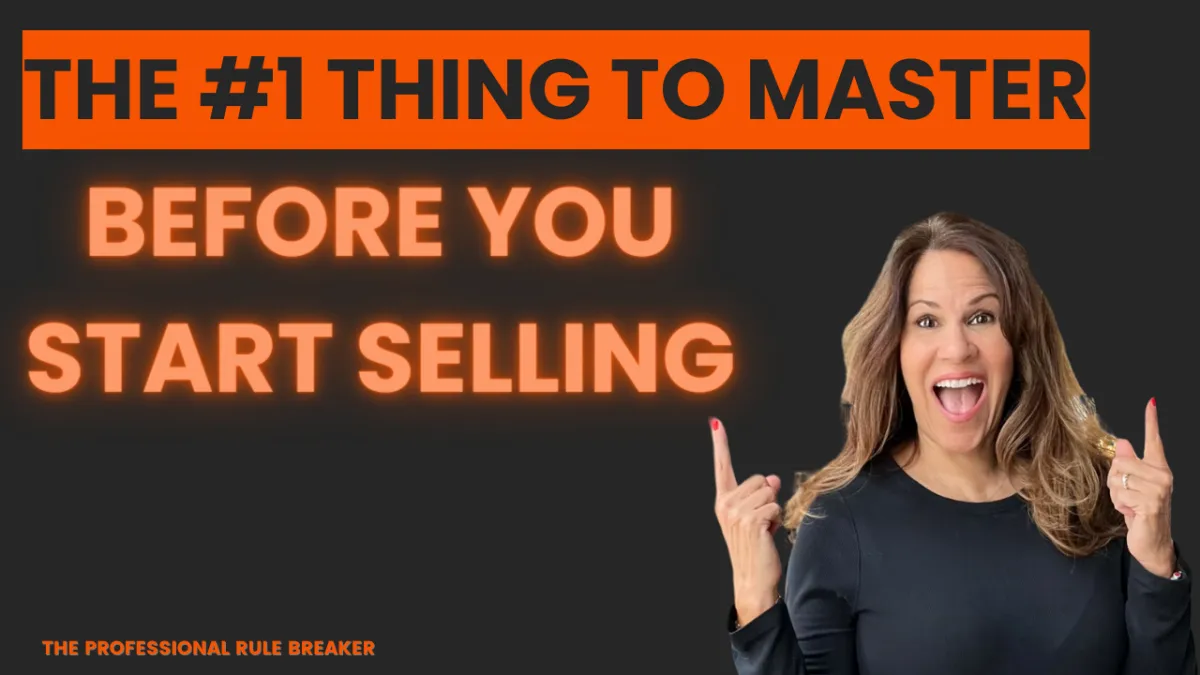LISTEN TO MY LATEST PODCAST EPISODE
looking for something?
Browse by Category

Identifying Your Dream Client for Maximum Sales Impact - Episode 93
Today, we will talk about the #1 thing you need to know before selling: who your dream client is for your value proposition.
You're probably thinking that you already know this, but that is one of the first things I talk to my clients about, and it's usually an area where there is some room for improvement.
Let me share an example with you. I was talking with a client, and I asked her to tell me about her target market, potential clients, or the clients she may have. She said she was selling to the corporate market, specifically big corporations. But she also mentioned having other customers, like stay-at-home moms, entrepreneurs, and solopreneurs. So, I asked her about her marketing strategy and how she worked with these different groups. It turned out that everything was exactly the same for all of them. She offered the same thing, said it the same way, and approached each type of customer without any distinction. I told her, "Okay, let’s refine this slightly. It’s fine to have different types of customers, especially if you’re a small company. But it can be overwhelming if you’re going after all of them at once. You need to have a different marketing strategy for each group and really know those customers inside and out."
So, we will talk about your dream client. You have to know that for your value proposition. When we start talking about selling, most people immediately think about the product or service that they're selling, but let me tell you something: the product is really only part of the equation.
The real magic happens when you understand everything about the person or company you are selling to.
So, who is your dream client?
And it's not just about demographics (like age, gender, location); it's really about getting into those really nitty gritty details:
What are their hopes, dreams, and challenges?
What keeps them up at night?
What are their desires?
What's their living situation?
Where do they live?
If you know everything about them and when you drill down on understanding your customers, I promise you that everything will change.
I want you to think about your client or your potential client as the person you want to hang out with because you want to, not because you have to. According to a report by HubSpot, businesses that deeply understand their customers see a 36% higher customer retention rate. If that's not enough, consider this research from Salesforce, which shows that 76% of consumers expect customers to understand their needs and expectations. But be honest; you will only know their needs or expectations if you drill down.
Understanding your customer is like having a superpower (that's actually one of my superpowers). It allows you to craft a value proposition that speaks directly to them. This is your promise of value that only you, uniquely, can bring to the table that meets their specific needs and desires. It's what you can help them with.
How do you identify a dream client?
So here are a couple of simple, actionable steps. The first is to create a detailed buyer persona. These can be semi-fictional representations of your ideal customer based on market research and real data about your existing customers. It includes details like:
What is their job role?
What are their biggest challenges?
What does success look like to them?
What's their pain?
What's their pleasure?
Where do they hang out with?
Where do they live?
Who do they hang out with?
Here is a little secret: if you already have a client in mind, note everything about them. You can give them a name because it's like you're talking to a real person. Whether your customer is a big corporation or an individual, the ultimate goal is to truly get to know them. The more you understand your customers, the better off you'll be. If you can get in front of them, engage and listen. You can use surveys, social media, and direct conversations to gather as much insight as possible. I promise you that the more you listen, the more you learn about them. But don't just listen to respond; listen to understand who they really are.
Once you have all the information, analyze your customer data. If you already have customers, look at your current customer base and identify the trends. Use the 80/20 rule, where 80% of your sales typically come from about 20% of your customers.
Who are your best customers?
What do they have in common?
What do they not have in common?
Use this information to refine your buyer personas and tailor your value proposition to them. When you tailor it to them, you know what their needs, wants, and pain and pleasure points are; it will make a difference.
Why does this matter?
When you know your dream clients inside and out, you can tailor your marketing messages directly to them, and they will resonate with you. Your offers become irresistible because they feel personalized, and people love personalization. According to Epsilon, 80% of consumers are likelier to do business with a customer if it offers personalized experiences. So not only does that boost your sales, but it also builds loyalty, and customer loyalty is huge. Customers who feel understood, valued, and heard are more likely to stick around. We all know that retaining a customer is so much more cost-effective than acquiring a new customer over and over again.
Here's your Pocket Ninja takeaway for today:
Before you start selling, invest some time in understanding your dream client. Then, create those buyer personas, give them a name, engage as much as possible with your audience, and analyze what they say to you, good or bad.
If you do this groundwork, it will pay off. And remember, you're not just selling a product or a service; you are offering a solution to your dream clients' problems right now. You are helping them reach the next step. Visualize this in your mind, like you are taking them by the hand and leading them down the path to where they want to go.
When you do this right, your sales will soar, and you will build a loyal customer base that champions your brand and helps with referrals. So, get referrals. They're going to be championing your brand and talking about you. So, take a few minutes and dive deep into who your ideal customer is.
If you need help, just contact theprofessionalrulebreaker.com. On the homepage, you will find my calendar, and I will give you 20 minutes for free, where I can help you sort out your ideal customer and help you go after that low-hanging fruit to bring some revenue into your business.
Connect with Kathy on social media:
Check out our sponsor
➡️ https://switchaway.com/rulebreaker
Rate, Review, & Follow on Apple Podcasts
Love The Professional Rule Breaker podcast? Show your support by leaving us a 5-star rating and review! It helps others discover us and join our rule-breaking community. Click here to rate, review, and don't forget to follow for more episodes!

